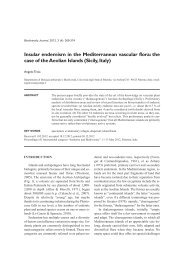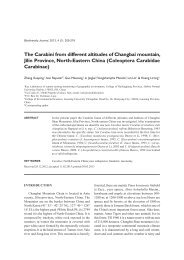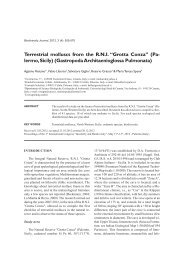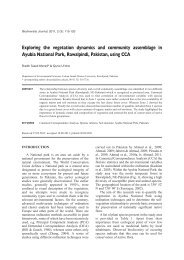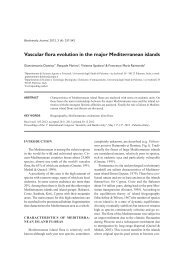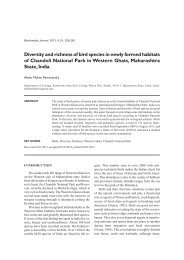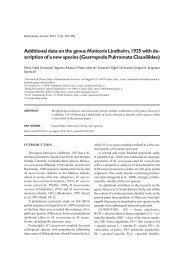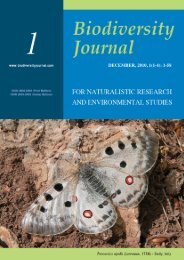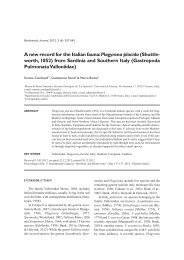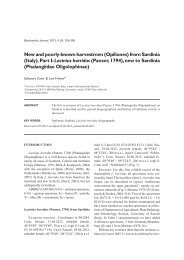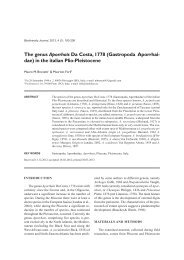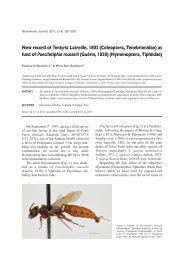Saliha Dermeche, Fayçal Chahrour & Zitouni Boutiba. Evaluation
Saliha Dermeche, Fayçal Chahrour & Zitouni Boutiba. Evaluation
Saliha Dermeche, Fayçal Chahrour & Zitouni Boutiba. Evaluation
You also want an ePaper? Increase the reach of your titles
YUMPU automatically turns print PDFs into web optimized ePapers that Google loves.
Biodiversity Journal, 2012, 3 (3): 165-172<br />
<strong>Evaluation</strong> of the toxicity of metal pollutants on embryonic<br />
development of the sea urchin Paracentrotus lividus (Lamarck,<br />
1816) (Echinodermata Echinoidea)<br />
<strong>Saliha</strong> <strong>Dermeche</strong> * , <strong>Fayçal</strong> <strong>Chahrour</strong> & <strong>Zitouni</strong> <strong>Boutiba</strong><br />
Laboratoire Réseau de Surveillance Environnementale (LRSE), Département de Biologie, Faculté des Sciences ,Université d'Oran,<br />
Algérie; e-mail: salidermeche@yahoo.it<br />
* Corresponding author<br />
ABSTRACT<br />
KEY WORDS<br />
Bioassays are frequently used to evaluate biological effects of pollutants on marine organisms.<br />
The objective of such tests is the detection of toxic effects on populations that are<br />
representative of a given ecosystem. Sea urchin is a model organism employed in the field<br />
of environmental toxicology due to its sensitivity towards various pollutants, particularly<br />
heavy metals. Preliminary bioassay tests on embryos and/or larvae of Paracentrotus lividus<br />
(Lamark, 1816) from Madagh (Oran, Algeria) were used to assess the potential toxicity<br />
and determine the LC 50 of four metal pollutants, Cadmium, Copper, Lead and Zinc.<br />
Bioassays; LC 50 ; Madagh; Heavy metals; Paracentrotus lividus.<br />
Received 22.05.2012; accepted 06.07.2012; printed 30.09.2012<br />
introdUCtion<br />
Inland aquatic and marine systems represent<br />
containers for virtually all contaminants, via direct<br />
and indirect contributions (Peijnenburg et al.,<br />
1997). Research on the action of heavy metals on<br />
the development of the sea urchin eggs represent an<br />
important contribution to the progress of knowledge<br />
in the field of embryonic determination.<br />
Sea urchin is a preferred model in such a research,<br />
due to a number of reasons including external<br />
growth of embryos, rapid cell division rate and cell<br />
transparency, thus being commonly employed in<br />
the field of Environmental Toxicology (Guillou &<br />
Michel, 1993; Quiniou et al., 1997). Bioassays or<br />
bio-tests frequently use several techniques to measure,<br />
predict and control the effect of the release of<br />
toxic substances on marine organisms.<br />
Present study examines the impact of four<br />
heavy metals, Cadmium, Copper, Lead and Zinc,<br />
on the embryonic development of the sea urchin<br />
Paracentrotus lividus (Lamarck, 1816) (Echinodermata<br />
Echinoidea).<br />
Materials and Methods<br />
We investigated the site of Madagh bay (Oran,<br />
Algeria: 35°37'952'' N; 000°104'243'' W) (Fig. 1),<br />
a non-impacted area, closed at its ends by two<br />
small caps reducing the action of winds. Moreover,<br />
the proximity of the Habibas island, which is<br />
considered a marine protected area, could make<br />
this site a reference station for comparative studies<br />
regarding the monitoring of pollution impacts<br />
in the coastal marine ecosystem of western Algeria,<br />
a site rich in algae and Posidonia meadows<br />
(Benghali, 2006).<br />
Collection of sea urchins was carried out during<br />
the period March-June 2010, when spawning is at<br />
its peak in this echinoid species. Spawning was induced<br />
by injection of 0.5 ml of 0.5 M KCl into the
166<br />
coelomic cavity of the sea urchin (Harvey, 1940);<br />
the male sex products were recovered "dried" and<br />
stored in melting ice. Moreover, sperms of several<br />
males were pooled. Females were placed in a 250<br />
ml Erlenmeyer flask containing filtered seawater<br />
(FSW) so that the genital pore was in contact with<br />
the surface of the water. After spawning, eggs were<br />
sieved with a 160 micron sieve and collected in a<br />
test tube. Volume was adjusted to 500 ml using<br />
FSW and homogenized. Subsequently, the first 100<br />
ml of the solution (containing eggs) was removed<br />
and replaced by FSW. This operation was repeated<br />
a second time (Dinnel et al., 1988; Quiniou et al.,<br />
1999; Guillou et al., 2000).<br />
Once suspensions of gametes were obtained,<br />
eggs and sperms were recovered separately in 2 ml<br />
of FSW. Fertilization was performed in beakers<br />
containing 1500 to 2000 oocytes to which 250 µl<br />
of sperm was added. After one hour of contact, we<br />
checked the fertilization success under a light microscope.<br />
Bioassays were carried out according to<br />
Coteur et al. (2003). A 15 well plate was used for<br />
each metal pollutant (Cd, Pb, Cu and Zn).<br />
Four different increasing concentrations (10<br />
μg/l; 50 μg/l; 100 μg/l; 200 μg/l) and a control solution<br />
(FSW), employed as blank, were used. Each<br />
well contained 10 ml of each solution, then 250-300<br />
embryos were transferred to each well and incubated<br />
for 72 hours at 21 ± 1 °C.<br />
S. DermeChe, F. <strong>Chahrour</strong> & Z. BoutiBa<br />
Figure 1. Sampling site: Madagh bay, Oran, Algeria.<br />
At the end, larval development was stopped by<br />
adding neutral formalin (35%) and the percentage<br />
of anomalies was determined according to the criteria<br />
of Klöckner et al. (1985). Number of malformed<br />
eggs/larvae, expressed in percentage, was<br />
assessed under the optical microscope by scanning<br />
slides containing about 100 eggs each. The<br />
number of dead cells was adjusted by the formula<br />
: % mortalities corrected = (Po – Pt)/(100 – Pt),<br />
where Po is the percentage of mortalities observed<br />
and Pt is the percentage of mortalities in controls<br />
(Abbott, 1975).<br />
Five replicates were performed for each concentration<br />
and each metal. The statistical treatment of<br />
experimental data was performed by the probit method<br />
(Bliss, 1935), which is useful for experiments<br />
with reduced number of animals and particularly<br />
suitable for research on marine invertebrates, as confirmed<br />
by Bendimerad (2000).<br />
resUlts<br />
The mean percentages of embryonic abnormalities<br />
observed in each heavy metal solution ± standard<br />
deviation are shown in Table 1.<br />
As shown in Table 1, concentrations of 10 μg/l<br />
and 50 μg/l determined minor negative effects on<br />
larval development. At 100 µg/l, the malformation<br />
percentage is about double or more (respect to 50
<strong>Evaluation</strong> of the toxicity of metal pollutants on embryonic development of the sea urchin Paracentrotus lividus<br />
[µg /l]<br />
Metals<br />
μg/l) depending on the metal, in particular, it resulted<br />
79.32% for Cd, 41.91% for Cu, 22.40% for Pb<br />
and finally 36.73% for Zn (Figs. 2-5).<br />
Graphs show results we partly expected: the<br />
more the concentration increases, the more the percentage<br />
of malformations is important, although,<br />
surprisingly, percentage of malformations observed<br />
after treatment with Cadmium at 200 μg/l is higher<br />
(88%) (Fig. 2) than that detected with the other metals:<br />
52.66% (Copper, Fig. 3), 40.33% (Lead, Fig.<br />
4) and 40.50 % (Zinc, Fig. 5).<br />
LC 50 , calculated according to the method of<br />
Bliss (1935), resulted 61.65 μg/l for Cd, 158.48 μg/l<br />
for Cu, 389.04 μg/l for Zn and 446.68 μg/l for Pb.<br />
disCUssion<br />
Geffard (2001), using Pb solutions at 10 μg/l<br />
and 50 μg/l, obtained, as percentages of malformations,<br />
14.8 ± 6.7% and 17.2 ± 3.9%, respectively;<br />
whereas, 100% of larvae with abnormalities were<br />
observed at 1200 μg/l. The LC 50 was 482.0 ±<br />
101.0 μg/l. The LC 50 value we found for Pb is<br />
446.68 μg/l. When comparing the two values, they<br />
appear to be very similar.<br />
In a previous study, carried out on the same species<br />
and in the same biotope, <strong>Dermeche</strong> (2010) reported,<br />
for Cd and Pb solutions at 10 μg/l,<br />
percentages of malformations of 8.33 ± 0.47% and<br />
10.66 ± 0.47%, respectively. At 200 μg/l the percentages<br />
passed to 82.33 ± 0.94% and 40.67 ±<br />
0.94% with a LC 50 of 69.18 μg/l for Cadmium and<br />
436.51 μg/l for Lead. Once again, these values are<br />
close to the values discussed in the present paper<br />
10 50 100 200<br />
Cd 7.31 ± 1.84 18.26 ± 2.97 79.32 ± 15.38 88.00 ± 14.60<br />
Pb 5.00 ± 1.68 12.20 ± 7.85 22.40 ± 7.97 40.33 ± 4.04<br />
Cu 5.93 ± 1.76 28.93 ± 4.52 41.91 ± 4.13 52.66 ± 24.61<br />
Zn 10.60 ± 2.70 17 ± 3.98 36.73 ± 10.32 40.5 ± 24.02<br />
Table 1. Mean percentages of abnormal embryos ± standard deviation observed in the sea urchin P. lividus from Madagh<br />
bay (Oran, Algeria) treated with four heavy metal solutions at different concentrations.<br />
167<br />
(61.65 μg/l for Cd and 446.68 μg/l for Pb). Many<br />
authors use Zinc and Copper to determine the LC 50<br />
by using the sea urchin larvae. According to Hall<br />
& Golding (1998), Ghirardini et al. (2005) reported<br />
that a concentration of 30 μg/l of Copper shows a<br />
negligible effect, while it takes a concentration of<br />
50 μg/l to observe the first malformed larvae. These<br />
results are consistent with those obtained by His et<br />
al. (1999) who observed developmental defects<br />
after treatment with a Copper solution at 60 μg/l.<br />
Our study gives a percentage of 28.93 of malformations<br />
at a concentration of 50 μg/l, a result that<br />
remains consistent with results obtained by different<br />
authors. Bougis & Corre (1974) suggested that the<br />
effect of Copper varies depending on the quality of<br />
brood stock. This would explain different results<br />
obtained. It is likely that gametes of poor quality<br />
are more sensitive to a toxic agent.<br />
Although echinoderms are capable of removing<br />
accumulated contaminants, the residence time in the<br />
body and the principal mode of elimination appear<br />
to depend on the metal (Warnau et al., 1997; Mannaerts,<br />
2007). According to Basuyaux et al. (2009)<br />
and Pétinay et al. (2009), larvae can develop up to<br />
a Copper concentration of 90 μg/l but malformations<br />
start appearing at 50 μg/l. Copper leads to a<br />
significant reduction in growth at 30 μg/l with larvae<br />
showing spicules reaching 464 ± 7 microns<br />
while normal ones generally are up to 495 ± 9 μm.<br />
Bielmyer et al. (2005) noted that abnormalities in<br />
larval development and, above all, the stop at pluteus<br />
stage were manifested at concentrations ranging<br />
from 40 to 80 μg/l.<br />
According to Fernandez & Beiras (2001), Cd<br />
causes 100% of arrest of development of the
168<br />
Figure 2. Percentage of deformed and normal larvae of<br />
Paracentrosus lividus observed after tretament with Cadmium<br />
solutions.<br />
Figure 4. Percentage of deformed and normal larvae of<br />
Paracentrosus lividus observed after treatment with Lead<br />
solutions.<br />
pluteus at 16 μg/l and the stop at blastula and gastrula<br />
stage at concentrations from 32 to 64 μg/l, respectively.<br />
Several studies demonstrated sensitivity<br />
of sea urchin embryos to heavy metals solutions in<br />
the range of 0.01-0.1 mg/l for Hg and Cu, and 0.1-<br />
10 mg/l for Cd and Pb (Waterman, 1937; Kobayashi,<br />
1981; Carr, 1996; Warnau et al., 1996).<br />
In a Cu solution at 64 μg/l, embryonic development<br />
was arrested at gastrula stage, and at morula<br />
stage at 128 μg/l. The toxic effects of Zinc on the<br />
larval development of sea urchin were as follows:<br />
the highest concentration used, 480 μg/l, completely<br />
inhibited the embryonic development; at very low<br />
concentrations (7.2 μg/l) no inhibitory effects were<br />
observed at first cleavage or at pluteus formation;<br />
S. DermeChe, F. <strong>Chahrour</strong> & Z. BoutiBa<br />
Figure 3. Percentage of deformed and normal larvae of<br />
Paracentrosus lividus observed after tretament with Copper<br />
solutions.<br />
Figure 5. Percentage of deformed and normal larvae of<br />
Paracentrosus lividus observed after treatment with Zinc<br />
solutions.<br />
exogastrula and Apollo-like gastrula were observed<br />
at concentrations ranging from 14 to 58 μg/l. At higher<br />
concentrations (120 to 240 μg/l), embryonic development<br />
and the elevation of the fertilization<br />
membrane showed signs of delay and even malformations,<br />
as well as polyspermies, permanent blastula,<br />
or exogastrula (Kobayashi & Okamura, 2006).<br />
Other metals known to cause exogastrulation in<br />
echinoids are: sodium selenite, cobalt chloride, zinc<br />
chloride or acetate, nickel, mercury chloride or acetate,<br />
the trivalent chromium and manganese chloride<br />
(Rulon, 1952; 1956; Timourian, 1968;<br />
Timourian & Watchmaker, 1970; Kobayashi, 1971;<br />
1990; Murakami et al., 1976; Pagano et al., 1982;
<strong>Evaluation</strong> of the toxicity of metal pollutants on embryonic development of the sea urchin Paracentrotus lividus 169<br />
Species<br />
Paracentrotus lividus<br />
Strongylocentrorus purpuratus<br />
Strongylocentrorus<br />
intermedius<br />
Arbacia lixula<br />
Mitsunaga & Yasumasu, 1984; Vaschenko et al.,<br />
1994); according to Lallier (1955) and Timourian<br />
(1968), skeletal malformations of pluteus were<br />
caused by Zinc whereas delay in skeletal development<br />
was always caused by Cadmium and Cobalt<br />
(Kobayashi, 1990; Mannaerts, 2007).<br />
King & Riddle (2001) showed that exposure<br />
of Sterechinus neumayeri embryos to various concentrations<br />
of Copper caused significant damages<br />
to the development at different stages and, particularly,<br />
at the stage of blastula; moreover, significant<br />
abnormalities were observed at a<br />
concentration of 4-5 μg/l. High mortality of embryos<br />
was estimated at a concentration of 16 μg/l,<br />
and abnormalities were observed at a concentration<br />
of 32 μg/l; a Copper concentration of 11.4<br />
μg/l caused 50% of developmental abnormalities<br />
after 6 to 8 days of exposure.<br />
Radenac et al. (2001) reported, for Cu solutions<br />
at 50 μg/l, about 36.9% of malformations which<br />
approximates the results (28.93%) observed, for<br />
the same concentration, in this study; however, at<br />
100 μg/l this rate reached 99.80% which exceeds<br />
our result (41.91%); 100% of larval malformations<br />
were obtained at 250 μg/l while our study showed<br />
52.66% of malformations at 200 μg/l. For Pb solutions,<br />
at 250 μg/l, a high percentage (96.6%) of<br />
malformation was reported. On the contrary, in<br />
our study, at 200 μg/l, we obtained only 40.33%<br />
of malformations. These results seem to suggest<br />
a different sensitivity of different species to<br />
Cu Cd Pb Zn References<br />
11 μg/l ---- ---- Pagano et al., 1986<br />
---- ---- ---- > 33μg/l Ramachandra et al.,1997<br />
---- ---- 0.21 - 0.26 μg /l ---- Warnau & Pagano, 1994<br />
---- ---- 482.68 μg /l ---- Geffard, 2001<br />
158.48 μg/l 61.65 μg/l 446.68 μg/l 389.04 μg/l present study<br />
6.3 μg/l ----
170<br />
Bendimerad M.E.A., 2000. Effets de la pollution<br />
cadmique sur une population de moules Mytilus<br />
galloprovincialis (Lamarck, 1816) - Notions<br />
de bioassai. Thèse Mag. LRSE. Biol. Poll.<br />
Mar. Université d'Oran, 116 pp.<br />
Bliss C.I., 1935. The calculation of the dosage<br />
mortality curve. Annals of Applied Biology,<br />
22: 134-167.<br />
Benghali S.M.A., 2006. Biosurveillance de la pollution<br />
marine au niveau de la côte occidentale<br />
algérienne par la mesure de l’activité de l’acétylcholinésterase<br />
chez la moule Mytilus galloprovincialis,<br />
l’oursin Paracentrotus lividus et<br />
la patelle Patella coerulea. Thèse. Mag. LRSE.<br />
Biol. Poll. Mar. Université d’Oran, 89 pp.<br />
Bielmyer G.K., Brix K.V., Capo T.R. & Grosell<br />
M., 2005. The effects of metals on embryolarval<br />
and adult life stages of the sea urchin,<br />
Diadema antillarum. Aquatic Toxicology,<br />
74: 254-263.<br />
Bougis P. & Corre M.-C., 1974. On a variation<br />
in sensitivity to copper larvae of the sea urchin<br />
Paracentrotus lividus. Comptes rendus<br />
de l'Académie des Science Paris D, 279:<br />
1301-1303.<br />
Basuyaux O., Chestnut C. & Pétinay S., 2009.<br />
Standardization of larval development of the<br />
sea urchin Paracentrotus lividus in assessing<br />
the quality of seawater. Blainville sur mer,<br />
France. Flight, 332: 1104-1114.<br />
Castagna A., Sinatra F., Scalia M. & Capodicasa<br />
V., 1981. Observations of the effect of zinc on<br />
the gametes and various development phases of<br />
Arbacia lixula. Marine Biology, 614: 285-289.<br />
Carr R.S, Chapman D.C., Howard C.L. & Biedenbach<br />
J., 1996. Sediment Quality Triad assessment<br />
survey in Galvestone Bay, Texas system.<br />
Ecotoxicology, 5: 1-25.<br />
Coteur G., Gosselin P., Wantier P., Chambost-<br />
Manciet Y., Danis B., Pernet Ph., Warnau M. &<br />
Dubois Ph., 2003. Echinoderms as bioindicators,<br />
bioassays and assessment tools of sediment<br />
impact-associated metals and PCBs in the<br />
North Sea. Archives of Environmental Contamination<br />
and Toxicology, 45: 190-202.<br />
Dinnel P.A., Pagano G.G. & Oshida P.S., 1988. A<br />
sea urchin test system for marine environmental<br />
monitoring. In: Burke R.D., Mladenov P.V.,<br />
Lambeet P. & Parsley R.L. (eds.), Echinoderm<br />
Biology, Balkema, Rotterdam, pp. 157-178.<br />
S. DermeChe, F. <strong>Chahrour</strong> & Z. BoutiBa<br />
Dinnel P.A., 1990. Summary of toxicity testing<br />
with sea urchin and sand dollar embryos. In:<br />
Culture and toxicity testing of West Coast marine<br />
organisms. Chapman G.A. (ed.). Proceedings<br />
of a workshop, February 27-28,<br />
Sacramento, CA. US EPA, Newport, OR, p.<br />
55-62.<br />
<strong>Dermeche</strong>. S., 2010. Indices physiologiques, bioessais<br />
et dosage des métaux lourds chez l’oursin<br />
comestible Paracentrotus lividus (Lamarck,<br />
1816) de la côte oranaise (ouest Algerien).<br />
These . Doc. Univ. Oran. LRSE, 137 pp.<br />
Fernandez N. & Beiras R., 2001. Combined Toxicity<br />
of Dissolved Mercury with Copper, Lead<br />
and Cadmium on Embryogenesis and Early<br />
Larval Growth of the Paracentrotus lividus<br />
Sea-Urchin. Ecotoxicology, 10: 263-271.<br />
Geffard, O., 2001. Potential toxicity of contaminated<br />
marine and estuarine sediments: Chemical<br />
and Biological Assessment, Bioavailability<br />
of sedimentary contaminants. Thesis Doct.<br />
Université de Bordeaux I, 328 pp.<br />
Ghirardini A., Volpi A., Novelli Arizzi A., Losso<br />
C. & Ghetti P.F., 2005. Sperm cell and embryo<br />
toxicity tests using the sea urchin Paracentrotus<br />
lividus (LMK). In: Techniques in Aquatic<br />
Toxicity, Vol. II. Ostrander G.K. (ed.) CRC<br />
Press, Danvers: 147-168.<br />
Guillou M. & Michel C., 1993. Reproduction and<br />
growth of Sphaerechinus granularis (Echinodermata:<br />
Echinoidea) in southern Brittany.<br />
Journal of the Marine Biological Association<br />
of the United Kingdom, 73: 179-193.<br />
Guillou B., Quiniou E., Huart B. & Pagano G.,<br />
2000. Comparison of embryonic development<br />
and metal contamination in several populations<br />
of the sea urchin Sphaerechinus granularis<br />
(Lamarck) exposed to anthropogenic pollution.<br />
Archives of Environmental Contamination and<br />
Toxicology, 39: 337-344.<br />
Guthrie F.E & Perry J., 1980. Introduction to environmental<br />
toxicology. Blackwell Scientific<br />
publication, 484 pp.<br />
Gnezdilova S.M, Khristoforova N.K. & Lipina<br />
I.G., 1985. Gonadotoxic and embryotoxic effects<br />
of cadmium in sea urchins. Symposia<br />
Biologica Hungarica, 29: 239- 251.<br />
Hall J.A. & Golding L.A., 1998. Marine sand dollar<br />
embryo (Fellaster zealandiae) short-term<br />
chronic toxicity test protocol. Niwa Taihoro<br />
Nukurangi, MFE80205. Appendix 2, 40 pp.
<strong>Evaluation</strong> of the toxicity of metal pollutants on embryonic development of the sea urchin Paracentrotus lividus 171<br />
Harvey E.B., 1940. KCl method. Biological Bulletin,<br />
Marine Biological Laboratory, Woods<br />
Hole, 79: 363.<br />
His E., Beiras R. & Seaman M.N.L., 1999. The assessment<br />
of marine pollution. Bioassays with<br />
bivalve embryos and larvae. Advances in Marine<br />
Biology, 37: 1-178.<br />
King C.K. & Riddle M.J., 2001. Effects of metal<br />
contaminations on the development of the<br />
common Antartic sea urchin Sterechinus neumayeri<br />
and comparisons of sensitivity with tropical<br />
and temperate echinoids. Australia, 215:<br />
143-154.<br />
Klöckner K., Roshental H. & Willfuhr J., 1985. Invertebrate<br />
bioassay with North Sea water samples:<br />
Structural effects on embryos and larvae<br />
of serpulids oyster and sea urchins. Helgol-<br />
Nnder Meeresuntersuchungen, 39: 1-19.<br />
Kobayashi N., 1971. Fertilized sea urchin eggs as<br />
an indicatory materials for marine pollution<br />
bioassay, preliminary experiment. Publications<br />
of the Seto Marine Biological Laboratory, 18:<br />
379-406.<br />
Kobayashi N., 1981. Comparative toxicity of various<br />
chemicals, oil extracts and oil dispersant<br />
extracts to Canadian and Japanese sea urchin<br />
eggs. Publications of the Seto Marine Biology<br />
Laboratory, 26 (1/3): 123–133.<br />
Kobayashi N., 1990. Marine pollution bioassay by<br />
sea urchin eggs, attempt to enhance sensitivity.<br />
Publications of the Seto Marine Biology Laboratory,<br />
34: 225–237.<br />
Kobayashi N. & Okamura H., 2006. Effects of<br />
heavy metals on sea urchin embryo development.<br />
Part 2. Interactive toxic effects of heavy<br />
metals in synthetic mine effluents. Chemosphere,<br />
61: 1198-1203.<br />
Lallier R., 1955. Effets des ions zinc et cadmium<br />
sur le développement de l’oeuf de l’oursin Paracentrotus<br />
lividus. Archives de Biologie,<br />
Liége et Paris, 66: 75-102.<br />
Mannaerts G., 2007. Effects of heavy metals on<br />
the morphology and mechanics of echinoid spines<br />
Echinus acutus. Submission to the graduation<br />
degree in Biology and Animal Biology<br />
direction, p. 31-35.<br />
Murakami T.H., Hayakawa M., Fujii T., Ara T.,<br />
Itami Y., Kishida A., Nishida I., 1976. The effects<br />
of heavy metals on developing sea urchin<br />
eggs. Okayama Igakkai Zasshi, 88: 39-50.<br />
Mitsunaga K. & Yasumasu I. 1984. Stage specific<br />
effects of Zn 2 + on sea urchin embryogenesis.<br />
Development, Growth & Differentiation, 26:<br />
317-327.<br />
Pagano G., Esposito A. & Giordano G., 1982.<br />
Fertilization and Larval development in sea<br />
urchins following exposure of gametes and<br />
embryos to cadmium. Archives of Environmental<br />
Contamination and Toxicology, 11:<br />
45-55.<br />
Pagano G., Cipollaro M., Corsale G., Esposito A.,<br />
Giordano G., Ragussi E. & Trieff N.M., 1986.<br />
Community Toxicity Testing, ASTM, STP. In:<br />
The sea urchin: bioassay for the assessment of<br />
damage from environmental contaminants.<br />
Cairns J. (ed.). American Society for Testing<br />
And materials. Philadelphia, USA, p. 66-92.<br />
Peijnenburg W., Posthuma L., Eijsackers H. &<br />
Allen H., 1997. A conceptual framework for<br />
implementation of bioavailability of metals<br />
for environmental management purposes.<br />
Ecotoxicology and Environmental Safety, 37:<br />
163-172.<br />
Pétinay S., Chataigner C. & Basuyaux O., 2009.<br />
Standardization of larval development of the<br />
sea urchin, Paracentrotus lividus, as tool for<br />
the assessment of sea water quality. Comptes<br />
Rendus Biologies, 332: 1104-1114.<br />
Quiniou F., Judas A. & et Lesquer-André E., 1997.<br />
Toxicité potentielle des eaux et des sédiments<br />
des principaux estuaires de la rade de Brest<br />
évaluée par deux bio-essais. Annales de l'Institut<br />
océanographique, 73: 35-48.<br />
Quiniou F., Guillou M. & Judas A., 1999. Arrest<br />
and delay in embryonic development in sea urchin<br />
populations of the Bay of Brest (Brittany,<br />
France); link with environmental factors. Marine<br />
Pollution Bulletin, 38: 401-406.<br />
Radenac G., Fichet D. & Miramand P., 2001. Bioaccumulation<br />
and toxicity of four dissolved<br />
metals in Paracentrotus lividus sea-urchin embryo.<br />
Marine Environmental Research, 51:<br />
151-166.<br />
Ramachandra S., Patel T.R. & Colbo M.H., 1997.<br />
Effect of copper and cadmium on three Malaysian<br />
tropical estuarine invertebrate larvae. Ecotoxicology<br />
and Environmental Safety, 36:<br />
183-188.<br />
Rulon O., 1952. The modification of development<br />
patterns in the sand dollar by sodium selenite.<br />
Physiological Zoology, 25: 333- 346.
172<br />
Rulon O., 1956. Effects of cobalt chloride on development<br />
in the sand dollar. Physiological<br />
Zoology, 29: 51-63.<br />
Timourian H., 1968. The effects of zinc on sea urchin<br />
morphogenesis. The Journal of Experimental<br />
Zoology, 169: 121-132.<br />
Timourian H. & Watchmaker G., 1970. Nickel uptake<br />
by sea urchin embryos and their subsequent<br />
change. The Journal of Experimental<br />
Zoology, 182: 379-387.<br />
Vaschenko M.A., Zhadan P.M., Malakhov V.V.<br />
& Medvedeva L.A., 1995. Toxic effects of<br />
mercury chloride on gametes and embryos in<br />
the sea urchin Strongylocentrotus intermedius.<br />
Russian Journal of Marine Biology, 21:<br />
300-307.<br />
Warnau M. & Pagano G., 1994. Developmental<br />
toxicity of PbCl 2 in the echinoid Paracentro-<br />
S. DermeChe, F. <strong>Chahrour</strong> & Z. BoutiBa<br />
tus lividus (Echinodermata). Bulletin of Environmental<br />
Contamination and Toxicology, 53:<br />
434-441.<br />
Warnau M., Lacarino M., De Biase A., Temara A.,<br />
Jangoux M., Dubois P. & Pagano G., 1996.<br />
Spermiotoxicity and embryotoxicity of heavy<br />
metals in the echinoid Paracentrotus lividus.<br />
Environmental Toxicology and Chemistry, 15:<br />
1931-1936.<br />
Warnau M., Teyssié J.-L. & Fowler S.W., 1997.<br />
Cadmium bioconcentration in the Echinoid Paracentrotus<br />
lividus: influence of the Cadmium<br />
concentration in seawater. Marine Environmental<br />
Research, 43: 303-331.<br />
Waterman A.J., 1937. Effects of salts of heavy<br />
metals on development of sea urchin, Arbacia<br />
punctulata. The Biological Bulletin, 73:<br />
401-420.



